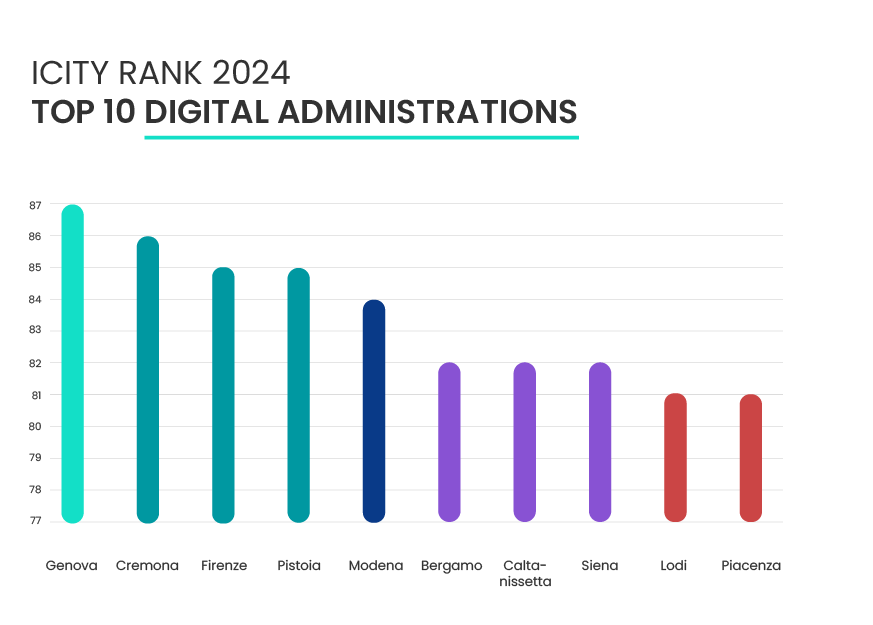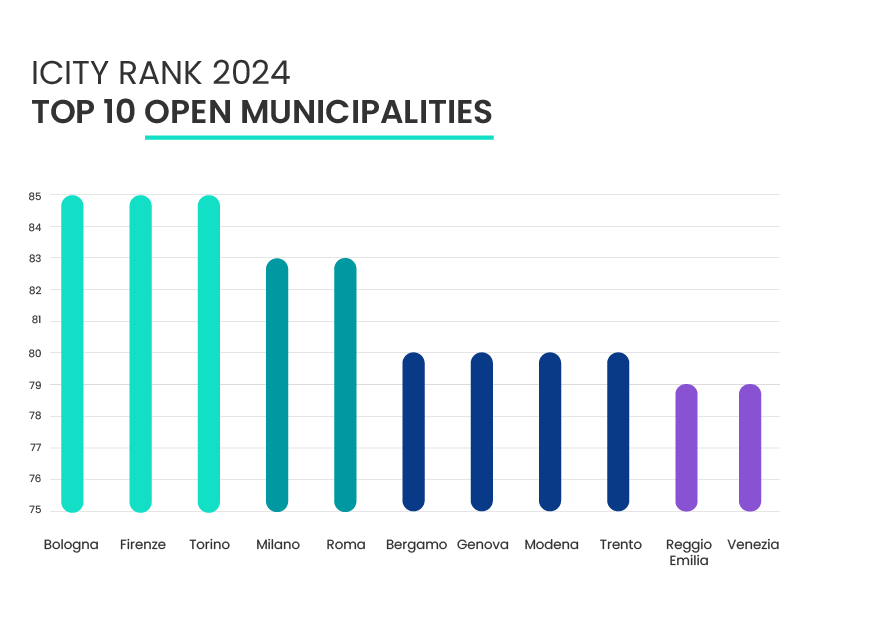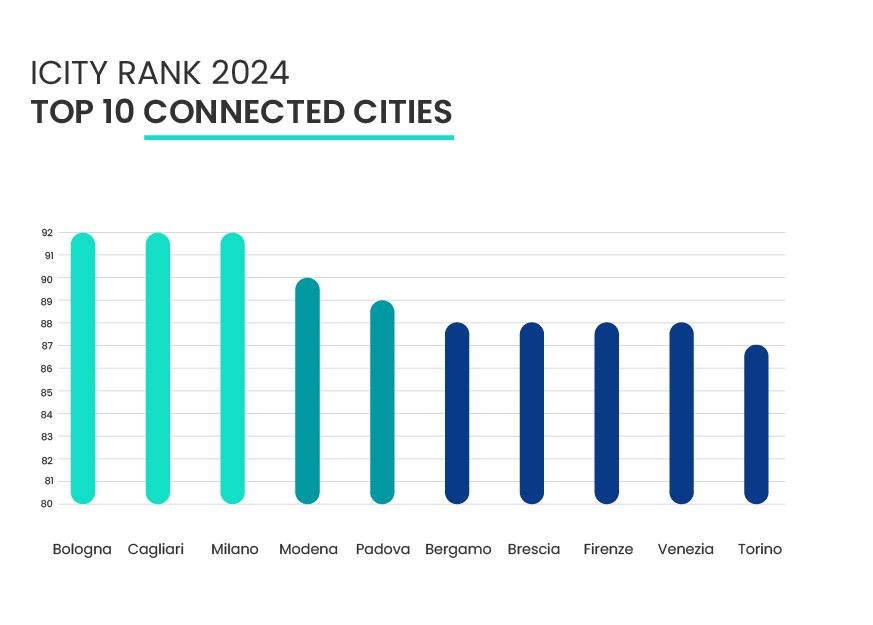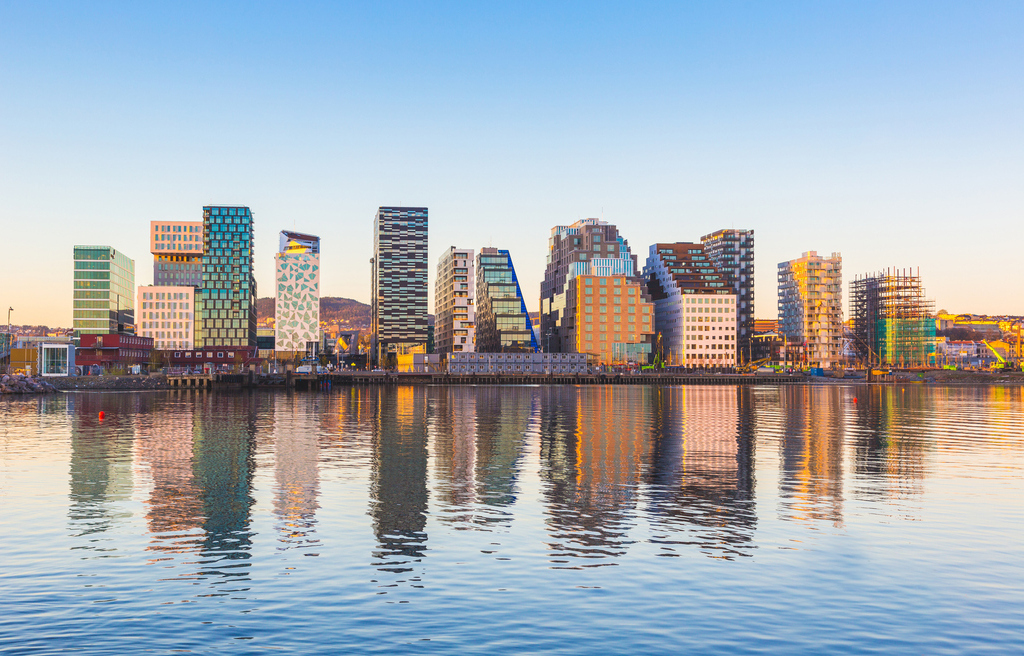For the City Vision Score, developed by Blum and the consulting firm Prokalos, the intelligence level of all Italian municipalities is measured on a scale from 1 to 110 by aggregating and synthesizing 30 indicators related to the six dimensions of smart cities (Smart Governance, Smart Economy, Smart Environment, Smart Living, Smart Mobility and Smart People, editor’s note). A strong gap persists between the North and the South of the country, with the North-East monopolizing the top positions.
Smart City in Italy: where do we stand, examples, projects and rankings
In 2023 the market for smart and sustainable Italian cities surpassed one billion euros for the first time. A figure destined to grow with PNRR funds, new investments from municipalities in cutting-edge technologies, and the contribution of initiatives such as Techstars Transformative World Turin.
The Italian Smart City market: growth, investments and prospects
For the Italian Smart City market, 2023 was a historic year during which, for the first time, investments in smart cities exceeded one billion euros. This is the main finding from the annual research conducted by the Smart City Observatory of the School of Management at the Politecnico di Milano, which however highlights that the annual growth (+11%) was more modest compared to that of other G20 countries, and in contrast to the 2022 growth (+23%). A slowdown caused by the priorities of the NRRP and hesitations in the distribution of funds from the Plan to the Municipalities.
The most funded technologies: Smart Mobility, public lighting and Smart Grid
Specifically, the growth recorded can be attributed to public investments in fundamental applications for Smart Cities: public lighting (23%), Smart Mobility (21%), remote reading and remote management systems for electricity, water and gas meters (Smart Metering), and intelligent information and power distribution networks (Smart Grid).
However, municipalities still face significant challenges in developing smart technologies, including a shortage of qualified personnel (52%), a lack of financial resources (48%) and an absence of internal expertise (47%). Nonetheless, the municipalities that have implemented smart city transformation projects have managed to reap benefits in line with or exceeding expectations (78%), with 86% of the surveyed municipalities planning to launch smart projects during the 2025-2027 triennium (58% in 2025, 28% in the following two years).
Emerging technologies for Smart Cities: Cloud Computing, Artificial Intelligence and IoT
Looking at cutting-edge technologies, municipalities are favoring Cloud Computing and innovative payments (with respective current project uses of 37% and 34%), while the Internet of Things (IoT) stands at 11%. Regarding Artificial Intelligence, the focus is directed to the future: while only 2% of projects currently include it, interest in new applications and designs reaches 31%.
Furthermore, the research shows that smart cities are considered more sustainable (50% versus 36% among residents of cities not considered smart), more inclusive (50% versus 32%), more innovative (49% versus 25%) and more efficient (49% versus 34%).


NRPP and Smart Cities: how funds for urban innovation are distributed
For the development of the Smart Cities market in Italy, NRRP funds play and will continue to play a crucial role, with the missions including smart city projects totaling 17.1 billion euros, distributed as follows:
Mission 1: digitalization of Public Administration
2.9 billion from Mission 1 for the digitalization of Public Administration, which includes a series of enabling interventions for Smart Cities;
Mission 2: ecological transition and urban sustainability
10.7 billion for Mission 2, which includes the ecological transition and the “green revolution,” aimed at increasing energy efficiency and sustainability through measures to reduce hydrogeological risks, the creation of renewable energy communities in small urban centers, and integrated territorial monitoring;
Mission 5: Integrated Urban Plans and Suburban Redevelopment
2.5 billion included in Mission 5, which provides specific funding for cities, intended for Integrated Urban Plans. The objective is to transform the peripheral areas of 14 Metropolitan Cities into smart and sustainable zones through the creation of new services for citizens and the digitalization of infrastructure.
What is the Smart City Index and how is it calculated
Determining the level of intelligence of cities is a challenging task, as there are no unique criteria necessary for an accurate assessment. However, universities and research centers have been producing rankings and ratings for years that can be used as a reference.
In this regard, one of the internationally recognized indicators is the Smart City Index (CSCI), which is calculated annually by the Smart City Observatory, a branch of the World Competitiveness Center (WCC) of the Swiss management school IMD together with the Singapore University of Technology and Design (SUTD). This ranking, which considers not only economy and technology but also other characteristic aspects of a Smart City such as inclusiveness and quality of life, includes in its top 20 a total of 11 European cities (6 from the EU), 7 from the Asia-Pacific region, and 2 from the Middle East.
Smart City Index 2024: the global ranking of smart cities
The top 10 smart cities in the world
In the 2024 edition of the Smart City Index, 142 cities worldwide were examined, with the top three positions remaining unchanged compared to the previous year and occupied by Zurich (Switzerland), Oslo (Norway) and Canberra (Australia). Geneva rises to fourth place, with Singapore in fifth and Copenhagen in sixth, while London, which dropped off the podium in 2022, now stands in eighth place, preceded by Lausanne.
The performance of Italian cities
Further behind are the Italian Smart Cities, which continue to lose ground: Bologna actually drops from the 51st to the 78th position, Milan slips even further and, mainly due to pollution, stands at the 92nd position (down from 52nd in 2019), while Rome does not enter the top 100, occupying the 132nd position—that is, the last among the smart cities of our country included in the rating.
ICity Rank 2024: digitalization of Italian cities
In Italy, the ICity Rank - which indicates the level of digitalization in cities - represents the main reference for tracking the evolution of Smart Cities. The research conducted annually by FPA - a company of the Digital 360 Group - assesses the digital transformation index of the 108 Italian provincial capitals, and, since 2023, is structured into 3 dimensions based on 37 indicators and 171 variables.
What is the ICity Rank and how does it work
ICity Rank is divided into 3 dimensions and is based on 37 indicators and 171 variables.
Digital Administrations
Digital Administrations
The “Digital Administrations” dimension concerns the digitalisation of administrative activities including websites, adoption of national platforms and use of online services


Open Municipalities
Open Municipalities
The “Open Municipalities” dimension analyses the level of use of social media, usability of apps and diffusion of open data.


Connected Cities
Connected Cities
The “Connected Cities” dimension indicates the impact of digital transformation on city governance, including sensor systems and related connectable devices, development of connection networks and tools for developing training flows and data analysis.


The fully digital cities in 2024
In the 2024 edition, the only fully digital cities—those scoring above 75/100 in all three dimensions—are Bergamo, Bologna, Florence, Genoa, Milan, Modena, Rome and Venice. Another 30 municipalities are accelerating their digital maturity journey, driven by NRPP funds and projects; among these, 8 (Brescia, Cagliari, Parma, Perugia, Reggio Emilia, Rimini, Turin and Trento) achieve scores above 75/100 in two categories and at least 50/100 in the remaining one, while another 22 (Bari, Bolzano, Cesena, Cremona, Cuneo, Ferrara, La Spezia, Livorno, Lodi, Messina, Monza, Naples, Padua, Palermo, Pavia, Pisa, Piacenza, Pescara, Prato, Siena, Verona and Vicenza) are close to reaching this milestone.


City Vision Score 2024-2025
What is the City Vision Score and how is it calculated
The 10 smartest cities in Italy in 2024
Milan confirms itself as the smartest city in Italy thanks to its strong performance in the Smart Economy dimension and mobility, with the largest municipalities acting as catalysts for those within a 50 km radius. In fact, Credera Rubbiano (Cremona) and Cordovado (Pordenone) complete the podium, with Imola (Bologna) in fourth position followed by Casaletto Vaprio (Cremona), San Secondo Parmense (Parma) and Arquà Petrarca (Padua). The top 10 is rounded off, in order, by Soverzene (Belluno), Collebeato (Brescia) and Ripalta Cremasca (Cremona).
The ranking of provincial capitals
With regard to provincial capitals, the gap remains, with Teramo being the only southern city among the top 50 in the rating, and three regions (Lombardy, Veneto and Emilia-Romagna) monopolizing the top 10. The podium, in fact, besides Milan, includes Treviso and Parma, while Vicenza is in fourth place ahead of Bologna, Padua, Pordenone, Brescia, Bergamo and Ferrara.
The cities in the top 20 and the role of Central Italy
In the top 20, Central Italy makes an appearance with Modena in eleventh place ahead of Pisa, Forlì, Florence, Piacenza and Monza, followed by Lodi, Trento, Turin and Ancona. In contrast, Rome Capital is further behind at the forty-sixth position and ranks only 1,412th overall among Italian municipalities.
The rating of Italian Smart Cities in the Politecnico di Milano Observatory Research
Finally, in the research conducted by the Smart City Observatory, Milan confirms itself as the smartest city in the country among Italians surveyed, followed by Bolzano and Trento, Bologna and Turin.
Examples of Smart Cities in Italy and innovative projects
Milan: smart mobility, digital twin and urban sustainability
Milan is the leading Smart City in Italy, with numerous projects aimed at improving sustainability and urban innovation. The Smart City Lab project—an R&D incubator—provides an environment where startups and companies can test innovative solutions in areas such as sustainable mobility, energy and the environment.
Within the framework of NRPP funds for digitalization and innovation in Public Administration, the Municipality of Milan has been selected to experiment with the Mobility as a Service project, which aims to promote greater accessibility, multimodality and sustainability in commuting by reducing the use of private transportation. In addition, there is Smart Parking, which uses IoT sensors to monitor parking availability and optimize urban traffic management.
Furthermore, the Lombard capital has launched the ForestaMi project, which aims to plant three million trees by 2030 to improve air quality and counteract pollution. Another initiative, launched at the beginning of 2025, is the Smart City and Extended Digital Twin development project, which, through a virtual replica of the city, aims to enhance urban planning and the management of public services.
Bologna: open data, civic participation and enhancement of the historic centre
Bologna stands out for its focus on digitalizing services and encouraging civic participation, as well as for having one of the most advanced public Wi-Fi networks in Europe. With the Bologna Smart City project, launched in 2012, the city aims to create a connected and innovative urban ecosystem through investments in digital infrastructures and the use of open data to improve the efficiency of public services.
One of the most ambitious initiatives in this provincial capital of Emilia-Romagna is the ROCK Project (Regeneration and Optimization of Cultural Heritage in Creative and Knowledge Cities), funded by the European Union, which seeks to transform the city’s historic centre into a model of sustainability through the digitalization of cultural heritage, energy-efficient upgrades to buildings, and the promotion of soft mobility.
Florence: intelligent traffic management and data-driven tourism
Florence has initiated a series of measures to improve traffic management, including the use of drones to reduce pollution and enhance the efficiency of public services. Firenze Digitale is a strategic plan that integrates advanced technologies to optimize public lighting, urban transportation and energy management.
Another significant initiative is Tourism Intelligence: a system based on Big Data and Artificial Intelligence that monitors tourist flows in real time. This allows visitors to be more evenly distributed among the various attractions of the city, avoiding overcrowding at the most popular sites while simultaneously improving the tourist experience.
Trento and Bolzano: energy communities and smart public services
Trento and Bolzano are among the most advanced Italian cities in terms of energy sustainability and innovation in public services. Both cities have developed Smart Grids, energy distribution systems that favor self-production from renewable sources and the creation of energy communities.
In Bolzano, the Sinfonia project launched in 2014 has improved the energy efficiency of several public and residential buildings through the use of advanced technological solutions and innovative materials. Trento, on the other hand, with its Trento Smart City initiative, promotes the digitalization of public services, the use of open data, and the creation of smart infrastructures for mobility.
Turin: smart mobility, AI and advanced urban experimentation
Turin is one of the most advanced Italian cities in the field of smart mobility and the application of Artificial Intelligence to urban services. The Torino City Lab project offers a space for testing new technologies, allowing companies to trial solutions for autonomous mobility, 5G connectivity and AI in a real urban setting.
One of the most ambitious projects is Skygate, which envisions creating a vertiport for drones and vertical take-off vehicles, intended for transporting people and goods. In addition, the “Muoversi a Torino” information portal integrates data on public transportation, shared mobility and smart parking to promote the use of alternatives to private cars.
Brescia: digital twin and autonomous vehicles for the urban future
Since late 2024, Brescia has been working on the creation of a Digital Twin through which the local administration aims to obtain all the necessary data for the transformation into a Smart City. The creation of a Digital Twin, for example, will enable the monitoring of traffic and public green areas, as well as mapping areas potentially at risk of extreme events and analyzing economic and tourism impacts.
At the same time, the city is experimenting with autonomous vehicles for car sharing, with the first trial in Europe conducted in January 2025, thus establishing itself as a laboratory of innovation.
Intesa Sanpaolo Innovation Center and Smart Cities: Techstars Transformative World accelleration program
Innovation therefore plays a fundamental role for Smart Cities, thanks to technological solutions developed by startups and, more generally, thanks to the paradigm of Open Innovation. In this context, Intesa Sanpaolo Innovation Center contributes to the development of Smart Cities as a partner of the international acceleration program “Techstars Transformative World”, dedicated to technologies for a changing world and promoted by the American company Techstars, one of the leading in the sector worldwide.
The accelerator, now in its second edition - started on February 24, 2025, at the OGR in Turin with 12 startups, six Italian and six international -, represents the evolution of the previous ones dedicated to Smart Mobility and Smart City launched in 2019, is managed by Techstars and supported by Intesa Sanpaolo Innovation Center, Fondazione CRT, and Fondazione Compagnia di San Paolo, with the active participation of the Municipality of Turin and local companies.
Considering all six years of activity, the program has positioned itself as one of the leading accelerators in Europe, supporting over a hundred innovative entities that have collectively raised more than 120 million dollars in investments, created over 600 new jobs, signed 80 agreements for POC (Proof of Concept), and achieved 3 exits.



